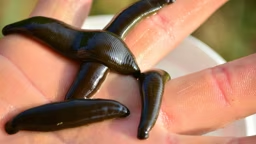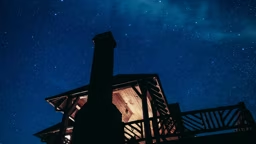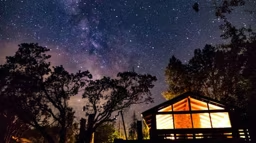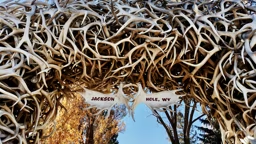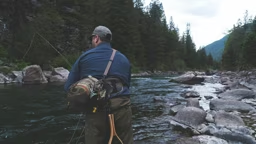Huddled together in a tight circle, my family had a chance to see the beauty of this tiny snake. Bold burgundy and white patches decorated its entire length, ending with a sharply marked pattern on the face, and its sides and belly were a delicate, smoky gray-blue. Even though I had lived and played in the woods of Wisconsin all my 38 years, this was my first eastern milk snake.
Powerful Beauty
Snakes are a prime example of the casual, effortless beauty so often found in nature. Look closely enough at any snake, and you will notice that each and every scale is unique, a work of art that blends seamlessly into a spectacular collage of colors racing down the snake’s body. The scales of the belly are broad, slick and, like a well-waxed ski, keep the snake from slipping backward while helping it to press forward. The piercing, black eyes observe you with the cool detachment of a skilled hunter. The tail tapers off to the most delicate, articulate wisp. Strong muscles and welterweight reflexes complete the picture of powerful beauty.
You’ve probably heard it before, but it is worth repeating that snakes do us all a favor with their persistent pursuit of all things pesky. Even so, the human instinct to shudder at the sight of a snake has its roots deeply entwined in the story of our survival. Avoiding creatures that could possess venom is a long-acquired behavior that is nurtured along by snakes’ fantastic displays of threat and warning.
Putting on a Show
A deeper exploration of snake displays reveals a subtle honesty about these creatures — they simply want to be left alone. While rattlesnakes may shake their noisemakers and bull snakes might puff and hiss a warning, other species put on more passive displays in the hopes of keeping the bigger and fiercer predators, like you, from eating them.
Hog-nosed snakes display threatening “eye spots” behind their head, but they also writhe upside down and look disgustingly dead. A red-bellied snake casually rolls its mid-section over to reveal its namesake bright swath that, in much of nature, says, “Careful, I taste really bad!” Garter snakes don’t give much of a display, but they do make a horrible musk, which they spread all over their body in a rapid writhing movement. Nature seems to have provided many ways in which these colorful and valuable assets to our landscape remain alive, healthy and undisturbed.
Face To Face
Encountering snakes in the wild is very rewarding, even if it can be a bit startling. Avoiding close contact with a snake is advisable, since some species are venomous and others can produce an otherwise nasty bite. Being careful not to hop over logs without looking becomes nearly as important as not taunting and harassing these legless reptiles. It is a good idea to teach children to take a few steps back from a snake when it is discovered.
Fortunately, most of the snakes a person might encounter belong to the primarily non-venomous family of snakes, the family Colubridae. These snakes tend to have smooth, rounded faces that lack the arrowhead shape of the venomous pit vipers.
It is, perhaps, more important that snakes are given a wide berth because of their relative fragility. While a pet snake can be handled time and time again, wild snakes may hurt themselves or surprise you into hurting them if you are an inexperienced snake handler. That long, serpentine body is supported by a backbone and peppered with dozens of delicate ribs. A fierce grab to the back of the snake’s head or a lightning quick pounce by an enthusiastic dad can cause severe damage.
Where in the World
Snakes inhabit a wide variety of habitats, from arid sand prairies to grassy lake borders, humid forests to pine groves, rocky outcroppings and even lakes and rivers.
? Riverbanks and associated habitats are great places to look for snakes closer to the fertile Mississippi Valley.
? In the arid west, I have had great luck along exposed slopes above pinyon pines.
? Boasting the most biological diversity for reptiles, the Appalachians are a real gem, a living museum of snake ancestry.
? Back home in Northwest Wisconsin, look for large snakes in the sandy prairies and dry oak forests. You can also find smaller beauties near wetlands, in fertile forests, and near overgrown fields.
If you give them the respect and distance they deserve, finding snakes can be a happy accident, and the species you’ll encounter is as random as where your walking takes you. Just about anywhere will produce a few beautiful snakes to admire.
Garter Snake.
Garter snakes are the most versatile of snakes, and can be found across the North American continent from Florida to Alaska. With such a broad range in geography, this common group of snakes has an equally broad range of coloration and diet. Unlike most other snakes, garter snakes have a constant and voracious appetite. They are also less dependent on the sun to jump-start their metabolism. They are non-venomous, but wild ones might bite.
Bull Snake.
A common snake of sandy soils, the bull snake spends its days in pursuit of burrowing mammals. When threatened, bull snakes put on a great show, puffing and rising like a cobra. Western varieties are more aggressive than eastern varieties, but all have a solid bite and a blood-thinning anticoagulant in the saliva. Though not at all poisonous, this is a snake that deserves a wide berth.
Fox Snake.
Aside from the hint of orange on their head, the fox snake is as brown as the duck hunter’s camouflage found at a sporting goods store. Fox snakes are talented hunters, climbing trees and descending into burrows. When threatened, they coil up and vibrate their tails in the leaf litter, completing a convincing imitation of a rattlesnake in both sight and sound.
Northern Water Snake.
I adore these aggressive snakes, with their blunt personalities and intriguing lifestyles. The northern water snake is a gifted swimmer and spends its time loafing around on partially submerged logs just at the water’s edge. Occasionally they will attempt, with great determination, to commandeer a ride in a canoe or slow-trawling motorboat. In my Northern Wisconsin cabin country,many people misidentify this harmless colubrid as a venomous water moccasin, a viper that is only found in the Southern United States.
Rattlesnakes.
In my career as a biologist, I have had the privilege of holding a few Eastern Massasauga rattlers. I also had a close call with a rattler along Washington’s Columbia River — these thick-bodied snakes command respect. But I grew up in timber rattlesnake country, and I have yet to get a good look at one of these elusive beauties. Rattlers and other vipers often pose a conflict of interest for landowners, who must choose between removing a deadly predator and letting the land’s original inhabitants stay. After all, they have been around eons longer than humans. Fortunately for us, they are not deserving of their bad rap, and usually give ample warning before striking.
Blue Racer.
Racing along through the forest floor, this large and fairly common snake is a great representative of the many non-venomous snakes in the family Colubridae. Moving at the pace of a brisk walk, the Blue Racer earns its name as the fastest of all North American snakes. Occupying a wide range and a great many habitats, this sometimes brightly colored snake is a great find.
Writer/photographer and biology teacher Brian M. Collins enjoys encounters with all animals and shares his joy of nature with family and students alike. See his photography at www.imagesinnaturallight.com.





